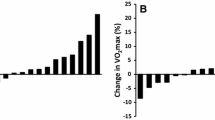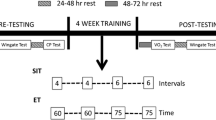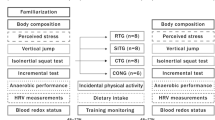Abstract
Purpose
Sprint interval training (SIT), involving brief intermittent bursts of vigorous exercise within a single training session, is a time-efficient way to improve cardiorespiratory fitness (CRF). It is unclear whether performing sprints spread throughout the day with much longer (≥ 1 h) recovery periods can similarly improve CRF, potentially allowing individuals to perform “sprint snacks” throughout the day to gain health benefits.
Methods
Healthy, young, inactive adults (~ 22 years, peak oxygen uptake [VO2peak] ~ 35 ml kg− 1 min− 1) were randomly assigned to one of two groups and performed 18 training sessions over 6 wks. Sprint snacks (SS) involved 3 × 20-s ‘all out’ cycling bouts separated by 1–4-h rest (n = 12, 7 females). Traditional SIT involved 3 × 20-s bouts interspersed with 3-min rest within a 10-min training session (n = 16, 7 females). The primary outcome was CRF determined by a VO2peak test conducted before and after training. Secondary outcomes included a 150 kJ cycling time trial and exercise enjoyment.
Results
Absolute VO2peak increased by ~ 6% after SIT and ~ 4% for SS (main effect of time P = 0.002) with no difference between groups (group × time interaction, P = 0.52). 150 kJ time trial performance improved by ~ 13% in SIT and ~ 9% in SS (main effect of time, P < 0.001) with no difference between groups (group × time interaction, P = 0.36).
Conclusion
CRF was similarly increased by a protocol involving sprint snacks spread throughout the day and a traditional SIT protocol in which bouts were separated by short recovery periods within a single training session.


Similar content being viewed by others
Abbreviations
- CIHR:
-
Canadian Institutes of Health Research
- CRF:
-
Cardiorespiratory fitness
- CSEP:
-
Canadian Society for Exercise Physiology
- EES:
-
Exercise enjoyment scale
- HR:
-
Heart rate
- MET:
-
Metabolic equivalent
- NSERC:
-
Natural Science and Engineering Research Council
- PAR:
-
Physical activity recall
- PAR-Q+:
-
Physical Activity Readiness Questionnaire-Plus
- RPE:
-
Ratings of perceived exertion
- SIT:
-
Sprint interval training
- SS:
-
Sprint snacks
- VO2 :
-
Oxygen uptake
- VO2peak:
-
Peak oxygen uptake
- W:
-
Watts
References
Bates D, Maechler M, Bolker B, Walker S (2015) Fitting linear mixed-effects modelus using lme4. J Stat Softw 67(1):1–48
Borg GA (1982) Psychophysical bases of perceived exertion. Med Sci Sports Exerc 14(5):377–381
Boyd JC, Simpson CA, Jung ME, Gurd BJ (2013) Reducing the intensity and volume of interval training diminishes cardiovascular adaptation but not mitochondrial biogenesis in overweight/obese men. PLoS One 8(7):e68091
Bray SR, Millen JA, Eidsness J, Leuzinger C (2005) The effects of leadership style and exercise program choreography on enjoyment and intentions to exercise. Psychol Sport Exerc 6(4):415–425
Burgomaster KA, Hughes SC, Heigenhauser GJ, Bradwell SN, Gibala MJ (2005) Six sessions of sprint interval training increases muscle oxidative potential and cycle endurance capacity in humans. J Appl Physiol 98(6):1985–1990
Burgomaster KA, Heigenhauser GJ, Gibala MJ (2006) Effect of short-term sprint interval training on human skeletal muscle carbohydrate metabolism during exercise and time-trial performance. J Appl Physiol 100(6):2041–2047
Cochran AJ, Percival ME, Tricarico S, Little JP, Cermak N, Gillen JB, Tarnopolsky MA, Gibala MJ (2014) Intermittent and continuous high-intensity exercise training induce similar acute but different chronic muscle adaptations. Exp Physiol 99(5):782–791
Francois ME, Baldi JC, Manning PJ, Lucas SJ, Hawley JA, Williams MJ, Cotter JD (2014) ‘Exercise snacks’ before meals: a novel strategy to improve glycaemic control in individuals with insulin resistance. Diabetologia 57(7):1437–1445
Gibala MJ, Little JP, Van Essen M, Wilkin GP, Burgomaster KA, Safdar A, Raha S, Tarnopolsky MA (2006) Short-term sprint interval versus traditional endurance training: similar initial adaptations in human skeletal muscle and exercise performance. J Physiol 575(3):901–911
Gibala MJ, Little JP, MacDonald MJ, Hawley JA (2012) Physiological adaptations to low-volume, high-intensity interval training in health and disease. J Physiol 590(5):1077–1084
Gillen JB, Percival ME, Skelly LE, Martin BJ, Tan RB, Tarnopolsky MA, Gibala MJ (2014) Three minutes of all-out intermittent exercise per week increases skeletal muscle oxidative capacity and improves cardiometabolic health. PloS One 9(11):e111489
Gillen JB, Martin BJ, MacInnis MJ, Skelly LE, Tarnopolsky MA, Gibala MJ (2016) Twelve weeks of sprint interval training improves indices of cardiometabolic health similar to traditional endurance training despite a five-fold lower exercise volume and time commitment. PloS one 11(4):e0154075
Godin G, Shephard R (1985) A simple method to assess exercise behavior in the community. Can J Appl Sport Sci 10(3):141–146
Ho B, Lim I, Tian R, Tan F, Aziz A (2018) Effects of a novel exercise training protocol of Wingate-based sprint bouts dispersed over a day on selected cardiometabolic health markers in sedentary females: a pilot study. BMJ Open Sport Exer Med 4(1):1–8
Jakicic J, Wing R, Butler B, Robertson R (1995) Prescribing exercise in multiple short bouts versus one continuous bout: effects on adherence, cardiorespiratory fitness, and weight loss in overweight women. Int J Obesity Relat Metabol Disord 19(12):893–901
Jenkins EM, Nairn LN, Skelly LE, Little JP, Gibala MJ (2019) Do stair climbing exercise “snacks” improve cardiorespiratory fitness? Appl Physiol Nutr Metabol. https://doi.org/10.1139/apnm-2018-0675
Metcalfe RS, Babraj JA, Fawkner SG, Vollaard NB (2012) Towards the minimal amount of exercise for improving metabolic health: beneficial effects of reduced-exertion high-intensity interval training. Eur J Appl Physiol 112(7):2767–2775
Metcalfe RS, Tardif N, Thompson D, Vollaard NB (2016) Changes in aerobic capacity and glycaemic control in response to reduced-exertion high-intensity interval training (REHIT) are not different between sedentary men and women. Appl Physiol Nutr Metabol 41(11):1117–1123
Milanović Z, Sporiš G, Weston M (2015) Effectiveness of high-intensity interval training (HIT) and continuous endurance training for VO2max improvements: a systematic review and meta-analysis of controlled trials. Sports Med 45(10):1469–1481
Myers J, Prakash M, Froelicher V, Do D, Partington S, Atwood JE (2002) Exercise capacity and mortality among men referred for exercise testing. N Engl J Med 346(11):793–801
O’Malley T, Myette-Cote E, Durrer C, Little JP (2017) Nutritional ketone salts increase fat oxidation but impair high-intensity exercise performance in healthy adult males. Appl Physiol Nutr Metab 42:1031–1035
Piercy KL, Troiano RP, Ballard RM et al (2018) The physical activity guidelines for Americans. J Am Med Assoc 320(19):2020–2028
Poole DC, Jones AM (2017) Measurement of the maximum oxygen uptake \(\dot{V}{\text{O}}_{2}\): VO2peak is no longer acceptable. J Appl Physiol 122(4):997–1002
R Development Core Team (2018) R: a language and environment for statistical computing. R Foundation for Statistical Computing
Sallis JF, Haskell WL, Wood PD, Fortmann SP, Rogers T, Blair SN, PAFFENBARGER RS Jr (1985) Physical activity assessment methodology in the Five-City Project. Am J Epidemiol 121(1):91–106
Sloth M, Sloth D, Overgaard K, Dalgas U (2013) Effects of sprint interval training on VO2max and aerobic exercise performance: a systematic review and meta-analysis. Scand J Med Sci Sports 23(6):e341–52
Songsorn P, Lambeth-Mansell A, Mair JL, Haggett M, Fitzpatrick BL, Ruffino J, Holliday A, Metcalfe R, Vollaard N (2016) Exercise training comprising of single 20-s cycle sprints does not provide a sufficient stimulus for improving maximal aerobic capacity in sedentary individuals. Eur J Appl Physiol 116(8):1511–1517
Stanley DM, Williams SE, Cumming J (2009) Preliminary validation of a single-item measure of exercise enjoyment: the Exercise Enjoyment Scale. J Sport Exer Psychol 31:S138–S139
Stork MJ, Gibala MJ, Martin KG (2018) Psychological and behavioral responses to interval and continuous exercise. Med Sci Sports Exerc 50(10):2110–2121
Vollaard NB, Metcalfe R, Williams S (2017) Effect of number of sprints in a SIT session on change in VO2max: a meta analysis. Med Sci Sports Exerc 49(6):1147–1156
Acknowledgements
J.P.L. is supported by a Canadian Institutes of Health Research (CIHR) New Investigator Award (MSH-141980) and a Michael Smith Foundation for Health Research (MSFHR) Scholar Award (16890). M.E.J. is supported by a MSFHR Scholar Award (5917). ML was supported by a Natural Sciences and Engineering Research Council (NSERC) Undergraduate Student Research Award. The authors would like to thank all the participants who volunteered their time and effort for this study and the following individuals who assisted in data collection: Lee Gye, Kyle Loney and Charles Zhou.
Author information
Authors and Affiliations
Contributions
JPL and MJG conceived the study design with assistance from MEJ, JL and EMC. JL, ML, GJ, EMC, and CD collected data, performed statistical analyses, and prepared figures. JPL, JL and ML wrote the first draft of the manuscript with input from all authors. All authors edited and approved the final version.
Corresponding author
Additional information
Communicated by Nicolas Place.
Publisher’s Note
Springer Nature remains neutral with regard to jurisdictional claims in published maps and institutional affiliations.
Rights and permissions
About this article
Cite this article
Little, J.P., Langley, J., Lee, M. et al. Sprint exercise snacks: a novel approach to increase aerobic fitness. Eur J Appl Physiol 119, 1203–1212 (2019). https://doi.org/10.1007/s00421-019-04110-z
Received:
Accepted:
Published:
Issue Date:
DOI: https://doi.org/10.1007/s00421-019-04110-z




